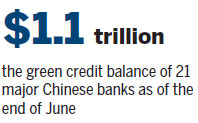CBRC pushes green finance
China's banking regulator has devoted great efforts to building a green credit policy system, leading banking institutions to support the development of an economy that is green, low carbon, and circular - meaning that it is designed to restore and regenerate resources.
Ye Yanfei, senior inspectorate adviser of the policy research bureau of the China Banking Regulatory Commission, said on Friday: "The CBRC has launched a series of guidelines on green credit since 2007, establishing a policy framework that defines clearly the boundaries of green credit policies, management approaches and performance evaluation methods."
On Wednesday, the CBRC, along with six other central government authorities, jointly issued the guideline on building China's green finance system, putting forward a series of measures to encourage investment in and financing of environmentally-friendly industries.
The CBRC also played a leading role in building an international communication and cooperation system for green credit, Ye said.
Initiated by the CBRC, the Sustainable Banking Network, a community of financial sector regulatory agencies and banking associations from emerging markets committed to advancing sustainable finance in line with international good practice, was formally launched in 2012. To date, 12 countries have launched national policies, guidelines, principles or roadmaps focused on sustainable banking.

Statistics from the CBRC show that, as of the end of June, the green credit balance of 21 major Chinese banks amounted to 7.26 trillion yuan ($1.1 trillion), accounting for 9 percent of their total loans. The loan balance of strategic emerging industries, such as new energy, was 1.69 trillion yuan, and the loan balance of energy saving and environmental protection projects and services reached 5.57 trillion yuan.
Compared with other loans, the asset quality of loans to energy saving and environmental protection projects and services is relatively good. As of June 30, their nonperforming loan ratio was 0.41 percent, or 1.35 percentage points lower than that of the total loan portfolio of 21 major banks.
The banking regulator said loans to energy saving and environmental protection projects and services have achieved significant environmental benefits. Every year, they are estimated to save 187 million metric tons of standard coal and reduce 435 million tons of carbon dioxide emissions, equivalent to the amount of carbon dioxide emissions that would be reduced by stopping 70,000 Beijing taxis for 298 years.
Tang Weiqi, research fellow at the research arm of Industrial and Commercial Bank of China Co Ltd, said green bonds have been growing rapidly in China during the last two years, with diversified market participants, including commercial banks, securities dealers and enterprises.
"In the first half of 2016, China issued about 58 billion yuan of green bonds domestically, accounting for 30 percent of the total worldwide. Starting from the second half, the growth of the Chinese green bond market further accelerated. We estimate that the domestic green bond market will reach 300 billion yuan by the end of this year, or half of the global market," he said.
jiangxueqing@chinadaily.com.cn
(China Daily 09/06/2016 page16)


















